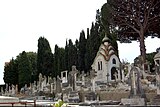Saint Roch Cemetery
- View a machine-translated version of the French article.
- Machine translation, like DeepL or Google Translate, is a useful starting point for translations, but translators must revise errors as necessary and confirm that the translation is accurate, rather than simply copy-pasting machine-translated text into the English Wikipedia.
- Consider adding a topic to this template: there are already 6,211 articles in the main category, and specifying
|topic=will aid in categorization. - Do not translate text that appears unreliable or low-quality. If possible, verify the text with references provided in the foreign-language article.
- You must provide copyright attribution in the edit summary accompanying your translation by providing an interlanguage link to the source of your translation. A model attribution edit summary is
Content in this edit is translated from the existing French Wikipedia article at [[:fr:Cimetière Saint-Roch (Grenoble)]]; see its history for attribution. - You may also add the template
{{Translated|fr|Cimetière Saint-Roch (Grenoble)}}to the talk page. - For more guidance, see Wikipedia:Translation.
Saint Roch Cemetery (French: Cimetière Saint-Roch) is the first municipal cemetery in the city of Grenoble, France. It was blessed by the bishop of Grenoble Claude Simon on 19 August 1810.[1] It is the largest cemetery in the city with 13 ha (32.12 acres).
Located on the rue du Souvenir, alongside the Isère, in the district of Île Verte, it is the city's only intramural cemetery, currently containing 25,000 graves over an area of 13 hectares (32.12 acres). The city has another cemetery, that of Grand Sablon, in the adjacent city of La Tronche.
Among those buried here are political leaders, military personnel, scientists and artists. The most important tombs however are of manufacturers of gloves. The sculptors Victor Sappey, Henri Ding, Eustache Bernard, Aimé Charles Irvoy and Urbain Basset are also buried here.
Many mayors of the city since the French Revolution are buried in this cemetery, from Joseph-Marie de Barral, mayor in 1790, to Albert Michallon, mayor from 1959 to 1965, as are the painters Jules Flandrin and Jean Achard and Camille Teisseire, representative for Isère in the French Chamber of Deputies (1820–1824) and Chevalier de la Légion d'honneur.
The most prestigious monument in the cemetery is the Saint Roch Chapel, built during the Bourbon Restoration in 1826 to replace the old chapel of the same name, built in the 15th century near a hospital for lepers.[1]
References
- ^ a b According to web site of Association Saint-Roch ! Vous avez dit cimetière ?
External links

- Saint-Roch ! Vous avez dit cimetière ? (in French)
- Saint Roch Cemetery on a web site for French cemeteries (in French)
- v
- t
- e
- Bagneux
- Batignolles
- Catacombs
- Errancis
- Gonards
- Grenelle
- Holy Innocents
- Les Invalides
- Levallois-Perret
- Madeleine
- Montmartre
- Montparnasse
- Montrouge
- Neuilly-sur-Seine
- Panthéon
- Pantin
- Passy
- Père Lachaise
- Picpus
- Saint-Denis
- Saint-Germain
- Saint-Ouen
- Saint-Vincent
- Sainte-Geneviève-des-Bois
- Sainte-Marguerite
- Saints-Pères
- Thiais

- Cannes (Grand Jas)
- Grenoble (Saint Roch)
- Lyon (La Guillotière)
- Lyon (Loyasse)
- Marseille (Saint-Pierre)
- Reims (Saint-Remi)
- Protestant Cemetery, Bordeaux
- Protestant Cemetery, Montpellier
- Jewish cemetery, Besançon
- Russian Orthodox Cemetery, Nice
- Aisne-Marne American Cemetery and Memorial
- Bény-sur-Mer Canadian War Cemetery
- Bretteville-sur-Laize Canadian War Cemetery
- Brittany American Cemetery and Memorial
- Epinal American Cemetery and Memorial
- Lafayette Escadrille Cemetery and Memorial
- Lorraine American Cemetery and Memorial
- Meuse-Argonne American Cemetery
- Normandy American Cemetery and Memorial
- Oise-Aisne American Cemetery and Memorial
- Orglandes German war cemetery
- Orry-la-Ville Dutch War Cemetery
- Rhone American Cemetery and Memorial
- Somme American Cemetery and Memorial
- St. Mihiel American Cemetery and Memorial
- Suresnes American Cemetery and Memorial












